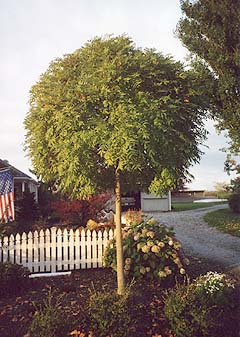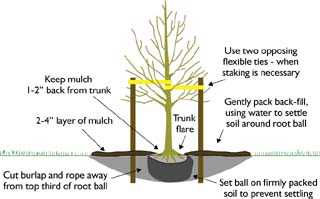
Surveys
DJC.COM
April 22, 2004
The do's and don'ts of planting new trees
Tree Solutions

Baker
|
There is a distressing lack of information on many landscape installation projects. Myths about trees are abundant and many workers in the landscape industry are not informed about current best practices. There is a tendency to sell and install plants that have the potential to live for decades with little planning for long-term management of the landscape.
Based on my own observations and many conversations with colleagues, not only are the people who actually end up planting new trees lacking training and knowledge, but many planners, professional landscape designers and landscape architects also appear to be working with outdated specifications. I often see planting details that are years out of date and are very likely to cause problems for the new trees.
Poor planting techniques are a common diagnosis made by arborists when asked to figure out what is wrong with failing trees and other recently planted landscape plants. Many arborists agree the problem is widespread and is costly for property owners and landscape managers, in the short term and over time.

Jim Barborinas of Urban Forest Nursery
Globe ash is a potentially useful tree for urban settings. This tree has never been pruned.
|
New construction sites present a specific set of circumstances and challenges for new plantings that are seldom exactly alike. Problems caused by grade changes and soil compaction may not be addressed in the plans and, as a result, there is seldom a plan for repairing the soil in the project budget.
It is possible to plan a construction project to include a healthy environment for new landscapes. Remember, many tree-covered neighborhoods and buildings with beautiful landscapes were construction sites years ago. My observation is that modern construction methods are harder on soils than in the past. A small amount of planning can ensure that the landscapes we build today grow to serve future generations.
I recommend the book “Principles and Practices of Planting Trees and Shrubs” by Gary W. Watson and E.B. Himelick as an excellent resource for those wanting to use current best practices for planting. Also useful is the pamphlet “New Tree Planting” available from the International Society of Arboriculture at http://www.isa-arbor.com.
Here are some common planting problems that I encounter often in my practice:
Planting too deep
Trees and woody shrubs are best planted with the first structural root at or near the surface. The term “trunk flare” describes the part of the plant where the trunk becomes root. This part of a tree or shrub should have no soil or mulch covering it!
Research has shown that trees planted too deep often form girdling roots that can cause unexpected tree failure in the future.
Not examining the root ball

Tree planting guidelines from the International Society of Arboriculture.
|
All, or as much as possible, of the various materials that are used to contain root balls should be removed at the time of planting. This includes twine that may be wrapped around the trunk of the tree. Research has shown that, contrary to popular belief, burlap and twine are slow to decompose and do cause problems for young trees.
Wire baskets have also been shown to last for a long time, and the upper portions often cause problems with new trees as they grow into the wire. Wire baskets should have the top half cut off once the tree is placed in the planting hole.
Contractors typically have reasons why they do not want to remove ball materials and baskets. Generally, these reasons have to do with time and labor costs.
Inspection of the root ball to find the trunk flare will also reveal other problems, such as plants that are root bound due to being in a pot or a ball for an extended time. It is feasible to adjust the root system at this time to help ensure that the new tree establishes healthy roots.
Poor site preparation
Trees and woody shrubs are best planted in the native soil where they are installed. No amendments or fertilization is recommended at the time of planting unless soil testing has revealed a deficiency.
Tree planting pits should be dug no deeper than the depth of the plants' root system, but twice or more the diameter of the root system. Planting into compacted soils on construction sites is the cause of many tree and plant problems. In many cases, landscape soils are simply spread in a thin layer over compacted soil that does not support root growth.
Any method that breaks up the compacted soil, creating pore spaces for air and water and allowing some of the new landscape soil to be incorporated into the disturbed soil, will improve plant survival.
Improper staking
Staking new trees is expensive. Material and labor costs for staking a new tree may exceed the cost of the tree. Improperly staked trees are often damaged immediately or within the first growing season by guy wires that girdle the trunk.
Only certain new trees such as bare rootstock, fabric bag, small container-grown trees and large transplants require support systems. Even these types of trees usually only need the help for a period of one year or less as roots quickly stabilize the new plant. Large transplant trees may require support for two years or more, but the stabilizing system may require adjustment during that period to prevent damage to the trunk.
Stake trees only when it is necessary. When stalking is needed, the support should be installed as low on the trunk as possible. Materials designed to minimize damage to the trunk of the tree are readily available. Some are designed to deteriorate and fall away if no one comes back to remove them. The use of wire with a piece of hose shown in many planting details is a poor method. My experience is that this method does not work reliably and that damage to new trees occurs often when it is used.
Poor species selection
Arborists call this “the wrong tree in the wrong place.” Trees are long lived. Trees grow a new layer or increment every year, often exceeding people's vision of what the tree they planted will become over time. Picking the right tree for the right place protects the initial investment in a new landscape tree.
With many new tree cultivars available, it is possible to find a tree that will fit the site as it matures. Understanding of the species characteristics of the tree you are planting is very important to avoid tree management problems in the future.
Scott D. Baker, principal arborist with Tree Solutions in Seattle, is a Registered Consulting Arborist with 30 years of experience.
Other Stories:
- Gardeners go trowel to trowel in contest
- Art meets Frisbees in north Seattle park
- What is your landscape telling you?
- Seattle's big chance to reconnect the waterfront
- Keeping runoff out of sight, but still in mind
- Ecological restoration goes beyond trees and shrubs
- Amgen unwraps the landscape at Helix
- Landscape designers promote active lifestyles
- Low-allergen landscapes nothing to sneeze at
- Shared streets can provide open space, too
- Landscape connects rivers and cultures
Copyright ©2009 Seattle Daily Journal and DJC.COM.
Comments? Questions? Contact us.